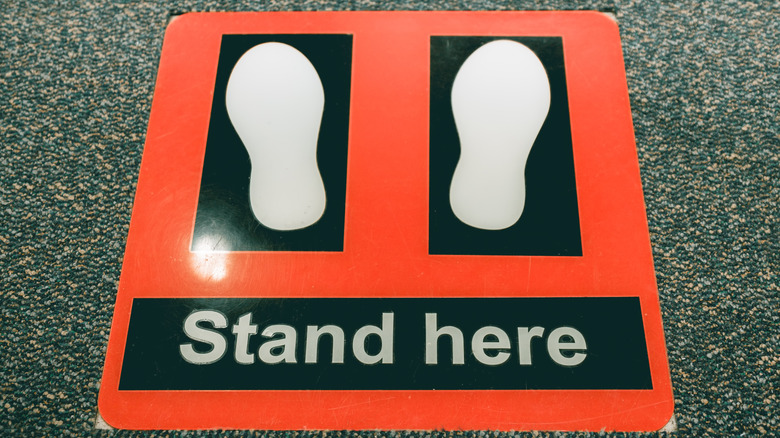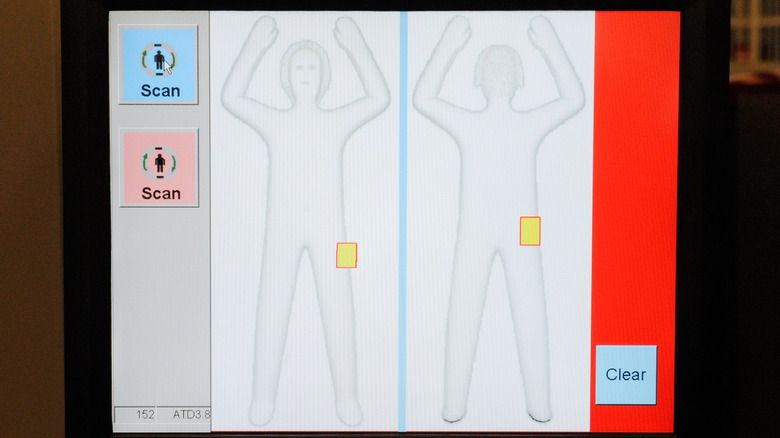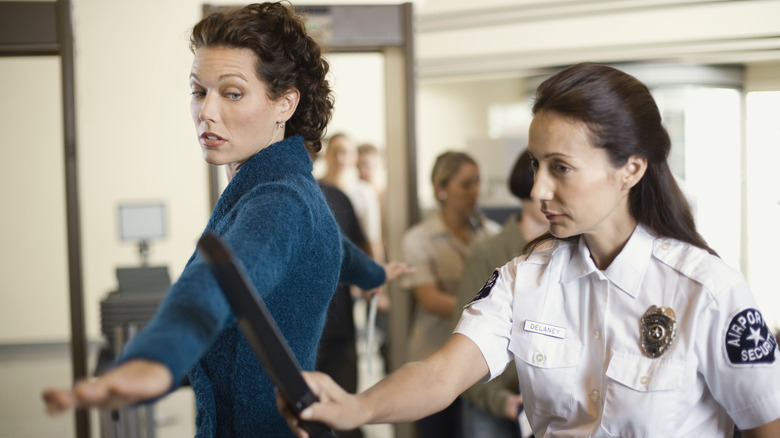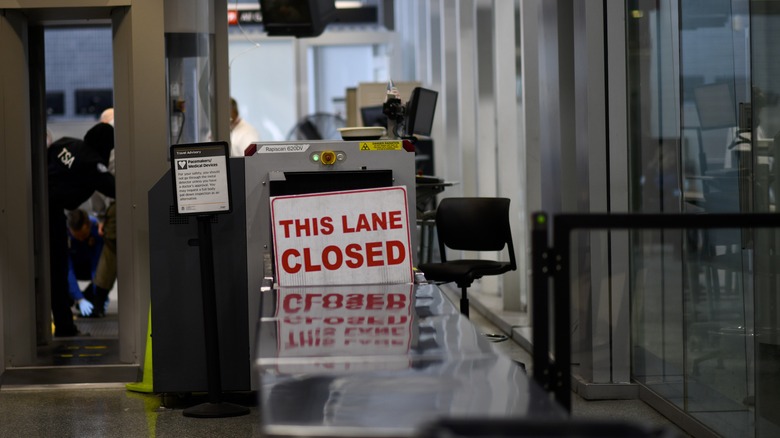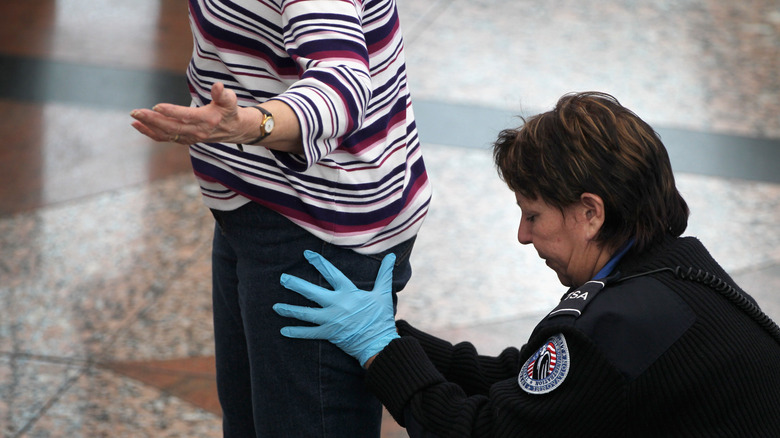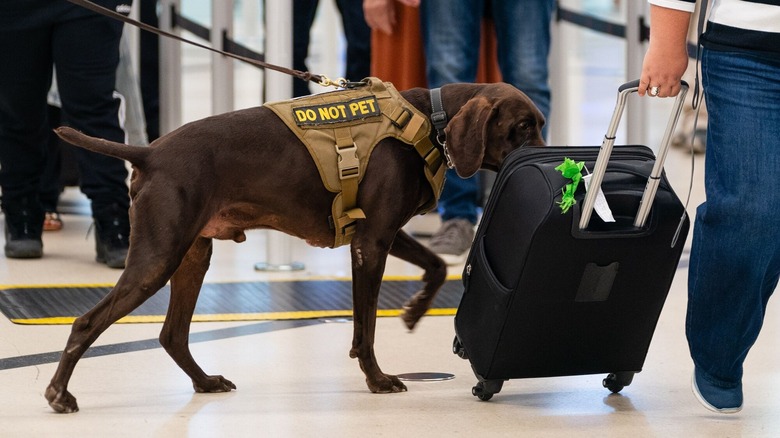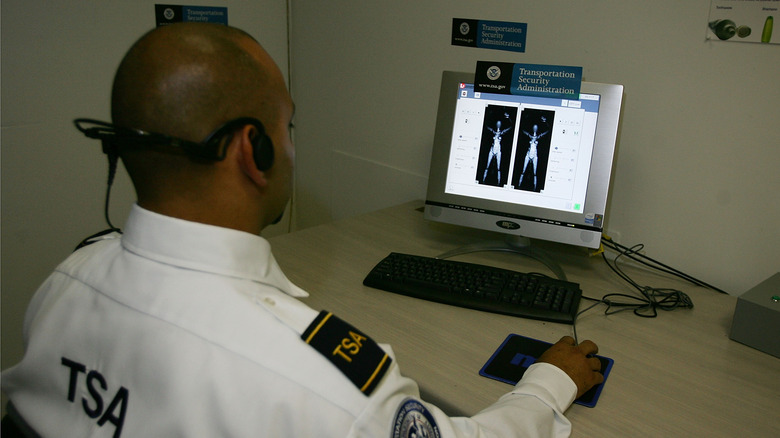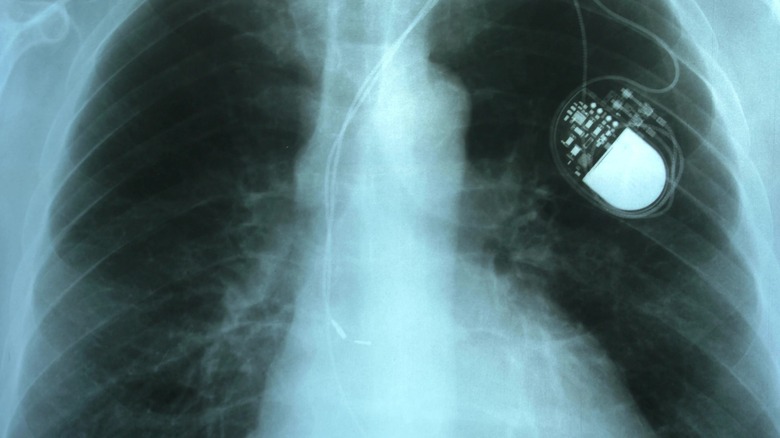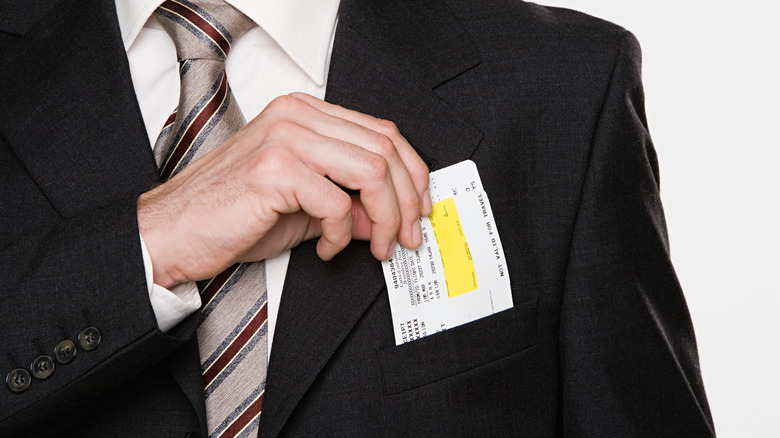The Oddest Things You Didn't Know About TSA Body Scanners
Oh, TSA body scanners. The awkward devices that require passengers to stand at attention and hold their arms up. Some travelers may not encounter these machines often, given that not every airport has full-body scanners. In fact, smaller airports typically still use metal detectors instead. But if you're flying through a big city airport or a hub, you'll likely encounter one of these machines as you pass through security.
According to the Environmental Protection Agency, these scanners differ from metal detectors because they use radiofrequency waves to locate unknown objects on passengers. The scanner will scan an individual; if it doesn't "see" anything worth detecting, it will allow the passenger through. If it does detect something, the image at the end will indicate to agents where the object is located on the person's body.
If you've wondered what these machines can (and can't) detect, a little knowledge can help you prepare for a scan to get through the airport without being flagged by the TSA for extra screenings. And what they can detect is only one of the odd things about TSA body scanners.
They can detect period hygiene products
Recently, a flying companion got pulled aside because a TSA body scanner detected her period underwear. And, as it turns out, even things like DivaCups may be detectable. That's right, not only can TSA scanners detect pads and thicker period underwear, but they can also potentially detect your menstrual cup, but this is debatable.
Regardless, the fact that TSA scanners can detect period products is news to us and apparently everyone else. In a survey by The Fornix, a blog run by the menstrual products company Flex, 90% of survey respondents were unaware of the scanner's ability. On top of that, 2.5% of those respondents told The Fornix that they had received additional screenings after their period products set off the body scanner. Very few outlets have covered this issue, though passengers told WSOC-TV that the pat down after setting off a scanner for menstrual products is quite intrusive.
The scanners supposedly can't detect things like tampons. While there is some anecdotal evidence to the contrary, in an interview with Reader's Digest, TSA spokesperson R. Carter Langston said, "Millimeter wave imaging technology does not detect items inside a passenger's body or penetrate the skin." While seemingly unavoidable, if you are a period-having person, it's worth knowing that the scanners may detect some hygiene products. Plan ahead and be prepared for additional screening.
Old scanners could make nude images of passengers
In the early 2010s, a handful of TSA scanners in operation became quite controversial. It was the early days of TSA body scanners, so it's no surprise that there were a few bugs to be worked out. However, this one takes the cake for privacy invasion.
These backscatter machines, some dubbed "virtual strip searches," created an almost NSFW scan of passengers. Thankfully, these have been replaced by a sketch of people without distinguishable characteristics. All 174 of these kinds of scanners were quickly removed from airports after understandable privacy concerns from passengers. Rapiscan, the manufacturer, was told to change the presentation mode of the scans but did not do so fast enough. "Due to its inability to deploy non-imaging Automated Target Recognition (ATR) software by the Congressionally-mandated June 2013 deadline, TSA has terminated part of its contract with Rapiscan," the TSA said via Wired.
After the systems were decommissioned, the scanners provided a generic image of a person with highlights indicating abnormal detections. That was a massive jump from the lifelike image scans these specific machines created. "It is big news," the Electronic Privacy Information Center executive director Marc Rotenberg told CNN. "It removes the concern that people are being viewed naked by the TSA screener." These scanners were considered both invasive and ineffective at detecting dangerous objects.
The radiation is generally harmless
Whether or not a TSA scanner poses a cancer risk to passengers depends on its type. Those that use ionizing radiation could pose a small cancer threat to users, even though the amount they radiate is minimal. Per Cancer Research UK, ionizing radiation may have a higher risk of giving users cancer if they are exposed to a lot of it. It also notes that people are regularly exposed to small amounts of ionizing radiation on a daily basis and that there isn't significant evidence to say TSA scanners increase cancer risk.
The consensus is that the millimeter-wave scanners at airports are typically harmless. "Scientists can never say that something is 100% safe, but I would say there's no plausible evidence by which millimeter waves could damage DNA," David Brenner, radiation biophysics professor at Columbia University Medical Center, told TIME. "If the risks are there, they're extremely small." Other medical experts also affirmed to TIME that the risks associated with TSA scanners are negligible.
TSA body scanners have been considered a waste of money
Not only are the scanners exorbitantly expensive, but there have also been reports of a lot of defunct equipment. The TSA has been criticized through the years for how much money it spends on body scanners, and these pricey machines have been known to sit around unused. Per a watchdog report given to ABC 13 WHAM, over $185 million worth of TSA equipment was located in the Transportation Logistics Center (TLC) warehouse in 2014, and according to an U.S. Congress oversight committee report in 2012, of the 472 carry-on screeners in storage, over 99% had been there for over nine months. Another 34% of those machines had been in storage for over a year.
Not only has the TSA spent hundreds of millions of dollars on these scanners, but it may not maintain them well enough — potentially leading to more money spent getting new ones or fixing them. In 2015, Politico acquired a series of reports on TSA operations. One such report from the inspector general indicated a woeful lack of maintenance. "TSA does not adequately oversee equipment maintenance, it cannot be assured that routine preventive maintenance is performed or that equipment is repaired and ready for operational use," read the report. At a whopping $125,000 a piece in 2012 (per that year's oversight report), you'd think the agency would take good care of the expensive equipment.
The machines have a high failure rate
So, the point of the body scanners is to detect weapons. Unfortunately, when tested, they fail 70% of the time, per documents given to Forbes. And that failure rate isn't new. The machines and staff have always had an uncomfortably high failure rate at detecting the thing they're supposed to detect. However, the 70% fail rate didn't seem so bad when a 2015 investigation found both the scanners and agents failed to detect weapons 95% of the time, according to Newsweek.
It should also be noted that the 70% rate was what was publicly disclosed in 2017. An insider who spoke to ABC affirmed that it was more like 80%. At the time, politicians diverted the issue and said appropriately maintaining TSA financially was suffering because of then-President Donald Trump's choices. "We have the technology and resources to do it, but we're not doing it because ... we're paying for a wall," Rep. Bill Keating said during a Congressional hearing.
Transgender passengers often feel othered by the machines
If you wore a romper to the airport and the waist bow is tied too tightly, this could trigger a pat down after the body scanner. Even as a TSA Pre-Check passenger who loves rompers, this is a frequent occurrence because the knot triggers the scanner. In short, the body scanners are programmed to detect unknown objects, which can lead to flagging transgender folks. In fact, many transgender travelers have reported uncomfortable additional screening and discomfort after scanners have essentially outed them.
Laura Jane Grace told Vice that 90% of the time when she flies, she sets off the body scanner — indicating a need for a pat-down. "I've been flagged for having an 'abnormality in the groin region'," she told the outlet. "In my opinion, there's no way this isn't direct, targeted harassment of trans people. If it's someone's job to ... watch the body scans of people as they go through the machine, and this person is flagging you because the shape of your flesh doesn't align with their idea of how a body should look, what else could it be?"
The TSA reported that in June 2023, it added a gender-neutral algorithm to the scanners, which reduced unnecessary scan triggers by 50%. However, it also said that which officer is assigned to do an additional pat-down is determined by "the officer's assessment of how you present." Note that you can ask for an officer of a specific gender.
Scanners have been criticized for racial profiling
The topic of racial profiling at the airport has plagued air travel since the birth of the TSA after the September 11 attacks. While much of that is conducted through human activity, the TSA body scanners have often been criticized as perpetuating racism at the airport. That's believed to be because they were not designed with diverse hair styles or head coverings in mind. So, hairstyles can trigger an additional security warning from the scanners.
An anonymous TSA agent told ProPublica that the technology isn't equipped to detect hair or hair coverings. "With black females, the scanner alarms more because they have thicker hair; many times they have braids or dreadlocks," the officer told the outlet. "Maybe, down the line, they will be redesigning the technology, so it can tell apart what's a real threat and what is not. But, for now, we officers have to do what the machine can't."
A 2014 government report also indicated other possible issues with the scanners. Other forms of headgear, like turbans or wigs, may have triggered them more often. False alarms were also potentially caused by passengers' weight, per the report.
You can opt out of a body scan
Believe it or not, only some passengers know they have a right to opt out of the full body scan. To do so, just let a TSA agent know while you're approaching the scanning area. Do know, however, that it might take more time to get a full pat down than to go through the scanner — if you're opting out to try and get ahead in line.
There is an exception to the opt-out rule. If you see "SSSS" on your boarding pass, indicating enhanced screening, you will not be allowed to opt out. Per the TSA, "some passengers will be required to undergo [advanced imaging technology] screening if their boarding pass indicates that they have been selected for enhanced screening, in accordance with TSA regulations, prior to their arrival at the security checkpoint."
Athlough sometimes the case, additional airport screening isn't totally random. However, if you aren't a frequent flier, you don't have to worry too much about the possibility as long as you don't engage in what the TSA views as suspicious behavior. Even if you fly a lot, chances are good that you won't see the dreaded "SSSS" label very often.
Scanners often can't find drugs
Unless you're walking into security with a big bag of drugs in your pocket, it's unlikely the TSA scanner will flag your stash. Why? Because it's programmed to find things on a person and not in a person. That means that drugs and other dangerous substances can technically get through the airport scanners if they are physically inside someone's body cavity.
That said, officers can swab your hands for traces of illegal or illicit substances like drugs or explosive residue. Despite the scanners being unable to detect some drugs, depending on how a traveler tries to smuggle them, that doesn't mean they miss every person who tries. Per the Phoenix New Times in 2010, the scanners, even early on, were better at finding satchels of drug paraphernalia than they were weapons.
It's fascinating that the machines may be triggered by internal menstrual products but not by people smuggling drugs. Though to be fair, TSA did state in April 2019 on Instagram that it isn't super interested in looking for drugs like cannabis. "Our screening procedures are focused on security and detecting potential threats," TSA wrote in its caption. "But in the event a substance appears to be marijuana or a cannabis infused product, we're required by federal law to notify law enforcement."
There was a time the scanners could store and send images
In 2010, it was revealed that the TSA body scanners could store and send images of passengers who went through them elsewhere. Although TSA claimed that wasn't true, research indicated that the machines could do it. Documents from 2008, obtained by the Electronic Privacy Information Center in 2010, noted that body scanners can store and send images. Via CNN, the documents explained that this process can only be done while the machines are in "test mode."
Yet TSA officials denied that possibility for agents. "There is no way for someone in the airport environment to put the machine into the test mode," the official told CNN. Later that year, the U.S. Marshals Service admitted that it had been saving images of tens of thousands of visitors via millimeter-wave scanners at a Florida courthouse. While those machines referenced by the U.S. Marshals Service weren't at an airport, they use the same technology as the ones used by airport TSA.
They are generally pacemaker friendly
TSA body scanners do not have a perfect track record for pacemakers. In 2014, a 30-year-old woman died after the scanner made her pacemaker malfunction. It should be noted that this incident happened at an airport in Russia, not in the United States. That said, freak incidents can occur.
However, the European Society of Cardiology's research on the safety of millimeter wave scanners at airports indicates that they are pacemaker- and defibrillator-safe. In the study, Dr. Carsten Lennerz of the German Heart Centre Munich, Technical University of Munich, and German Centre for Cardiovascular Research determined that the scanners should not cause interference.
"We found no evidence of electromagnetic interference or device malfunction with the full body scanner we tested and can conclude that scanning is safe for patients with implanted cardiac devices," Lennerz announce in an ESC press release. "This may be because cardiac devices filter out high frequency signals such as millimetre waves, the waves hardly penetrate the body at all, and the scan time is very short (usually around 100 milliseconds)."
Machines struggle with interior pockets
As we mentioned previously, TSA body scanners could be better at seeing internally concealed items. However, if you're trying to sneak through with something in a pocket, pant leg, or elsewhere, there's a good chance the scanner will pick it up. That is the main reason airports use these scanners: to allow security to see most concealed items. Yet, interior pockets are one kind of concealment that the scanners struggle with. Blogger and civil rights attorney John Corbett did an experiment in 2012 in which he sewed a small metal can into the side of his shirt. On his blog at the time, he posted a video and claimed that his experiment worked, as the scanner did not pick up the item.
"Maybe a fluke?" he wrote of his alleged successful first attempt. "Ok, let's try again at Cleveland-Hopkins International Airport through one of the TSA's newest machines: a millimeter wave scanner with automated threat detection built-in. With the metallic object in my side pocket, I enter the security line, my device goes through its own x-ray, I pass through, and exit with the object without any complaints from the TSA." Corbett also claims to be the first person to sue the TSA for using the virtual strip search body scanners.
